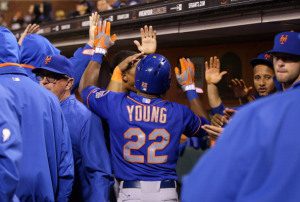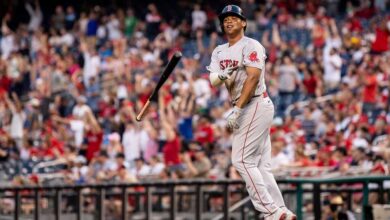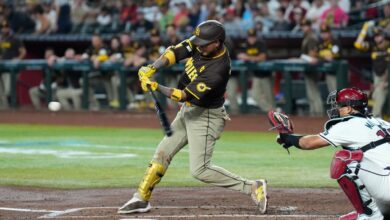

As the New York Mets head into the offseason, one oft-discussed topic is the 2014 role of left fielder and leadoff hitter Eric Young Jr.
Acquired early in the summer, Young helped revamp the Mets’ outfield, which morphed from a glaring weakness to a consistent source of excitement. Young routinely struggled to get on base consistently, but when he did get on base, he was electric. He took extra bases, hustled on play after play, and finished the season with the National League stolen base title.
Eric Young Jr. has deficiencies in the outfield, namely a weak throwing arm and a hard time going back on the ball, but he’s also made a number of game-saving and inning-saving diving catches. The problem is, compared with Matt Den Dekker and the astounding Juan Lagares, Young’s fielding deficiencies seem particularly glaring. There are ample reasons to believe that Young, despite his weak batting average, could have a future atop the Mets lineup, especially if they acquire a power bat. A low batting average and a weak throwing arm in left field are hard to justify, even in a player who provides, hustle, electricity and a great example for younger players. Furthermore, having him in left field prohibits the acquisition of a power-hitting outfielder. Fortunately, Eric Young Jr. is also a second baseman by trade.
Moving Eric Young Jr. to second base would have two primary effects:
1. It would free the Mets to use Wilmer Flores and/or Daniel Murphy, both promising hitters who are average defensive second basemen, as trade bait. Flores or Murphy, packaged with a pitching prospect or a draft pick, might be able to land the kind of power hitter the Mets really need. Ideally, they could acquire shortstop Troy Tulowitzki from the Colorado Rockies, in exchange for a couple of young players and maybe the work-in-progress shortstop Ruben Tejada. And if they were to acquire a big hitter like Carlos Gonzalez without giving up Tejada, then the lineup would be strengthened enough to be worth giving Tejada a chance to right the ship. Then the Mets could move Lagares behind Young to provide a 1-2 speed combination at the top of the order.
2. Lucas Duda batted second in the order in the final games of the season, which is also an intriguing prospect. Duda is a powerful lefty who uses the entire field, and with Young tearing up the bases in front of him and a power bat hitting fourth or fifth, David Wright would have both lineup protection and RBI opportunities. And if the Mets were to trade Duda, then Murphy or Flores could be moved to first base, and both seem like good candidates to bat second. Last but not least, Young would be moving to a position that’s a more natural fit for him.
However you slice it, moving Eric Young Jr. to second base is worth serious consideration for the New York Mets.





